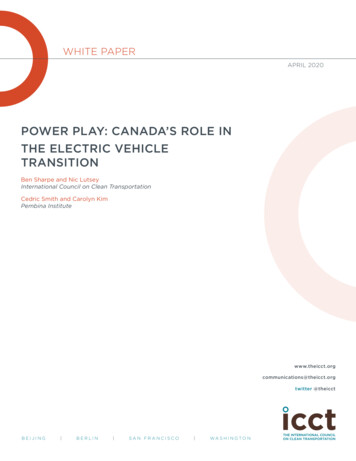
Transcription
WHITE PAPERAPRIL 2020POWER PLAY: CANADA’S ROLE INTHE ELECTRIC VEHICLETRANSITIONBen Sharpe and Nic LutseyInternational Council on Clean TransportationCedric Smith and Carolyn KimPembina twitter @theicctBEIJING BERLIN SAN FRANCISCO WA S H I N G TO N
ACKNOWLEDGMENTSThis study was funded by the Heising-Simons Foundation and the Energy Foundation.The authors appreciate the reviews of Drew Kodjak of the International Council onClean Transportation, Jessica Lof of Canadian Energy Systems Analysis Research, andMark Kirby of the Canadian Hydrogen and Fuel Cell Association. Their input was helpfulin strengthening the data sources and methodology used in this study. The researchcontributions of Maddy Ewing and Vincent Morales of the Pembina Institute are alsoappreciated. The authors wish to thank the following organizations, who generouslyprovided their insights and knowledge on this subject matter to inform this research:Canadian Urban Transit Research and Innovation Consortium (CUTRIC), Nova Bus,and the GreenPower Motor Company. The views expressed in this publication are theviews of the ICCT and the Pembina Institute and do not necessarily reflect those of theorganizations that were engaged in the research and development of this report.International Council on Clean Transportation1500 K Street NW, Suite 650Washington DC 20005 USAcommunications@theicct.org www.theicct.org @TheICCT 2020 International Council on Clean Transportation
EXECUTIVE SUMMARYAutomotive technology continues to evolve at an especially rapid pace due to thecontinued technical improvements in electric vehicles. Globally, light-duty electricvehicle sales have grown over 60% per year since 2012, to over 2 million in 2018.Electric vehicles represent the most significant alternative powertrain since the dawnof combustion vehicles in the early 20th century. The annual growth in electric vehicleand electric heavy-duty vehicle sales has averaged 60% and 140% per year between2012 and 2018, respectively. Nearly all these electric vehicles are in China, Europe,and North America, where clean air and climate change are top priorities and wheresupporting policies are being continually implemented to accelerate the transition.This paper evaluates Canada’s position in the emerging global electric vehicle industryby analyzing sales and production trends for conventional and electric vehicles andcomparing these trends to similar auto markets around the world. By examiningCanada’s electric vehicle market and assembly developments, and comparing thosewith activities in other manufacturing countries, we identify underlying policies thatCanada could use to ensure they remain an integral part of the rapidly evolving globalautomobile industry.Figure ES-1 shows light-duty vehicle production (x-axis) and electric vehicle production(y-axis) by country in 2018. Electric vehicle manufacturing in the countries above thedotted line is greater than 2.3% of their total vehicles produced; conversely, electricvehicles account for less than 2.3% of vehicle production for countries below thisline. China leads with 4.2% of its 25 million vehicles produced being electric, andothers like Germany and the United States are at the leading edge of the transition toelectric vehicle manufacturing. Each of these three countries make more than 5 millionvehicles per year, and electric vehicles accounted for 3% to 4% of their production in2018. At roughly 2 million vehicles manufactured per year, Canada is the 12th largestvehicle producer, but electric vehicle production, at 0.4%, is 80% lower than the globalaverage. As shown, many other high vehicle-producing countries, such as South Korea,France, the United Kingdom, and smaller-producing countries like Slovakia, Austria,Sweden, and the Netherlands, have much larger shares of electric vehicle productionthan Canada.iICCT WHITE PAPER POWER PLAY: CANADA’S ROLE IN THE ELECTRIC VEHICLE TRANSITION
Electric vehicle production (thousand per year)1,000The area of the bubbles corresponds withthe country’s percentage of total vehicleproduction that is electric (including plug-inhybrids and hydrogen fuel cell ia1.0%Dotted line represents the 2018 globalaverage of 2.3% electric vehicle y vehicle production (thousand per year)Figure ES-1. Light-duty vehicle production, electric vehicle production, and electric vehicle shareof production by manufacturing country in 2018Canada ranks 5th globally in commercial vehicle production at nearly 1.4 millionvehicles produced in 2018, and it exports close to 3 billion in vehicles from the heavyduty sector. As with sales for zero-emission commercial trucks and buses, China hasdominated the global production of electric heavy-duty vehicles. Canada ranks sixthin the world in electric heavy-duty vehicle production, despite a relatively small share(0.1%). Canada’s overall heavy-duty vehicle manufacturing sector has shown robustgrowth since the early 2010s, with sharp increases in both exports and revenues.Based on the findings from this paper, Canada holds a prominent stake in the globalautomotive industry, but that position could be strengthened with stronger actionto support the transition to electric vehicles. The analysis reveals the followingconclusions and policy recommendations:Canada’s auto industry lags behind other auto-manufacturing countries in itspreparation for an electrified transportation future. Canada is committed toelectrifying its on-road vehicles as part of the country’s overall decarbonizationstrategy. However, particularly in the light-duty vehicle sector, stronger policies inother countries are driving electrification and attracting electric vehicle investments.Chrysler, Ford, General Motors, Honda, and Toyota production facilities in Ontario aredominated by internal combustion vehicles, while these same companies are makingbillion-dollar investments to produce electric vehicles in China, Europe, and the UnitedStates. Ontario has historically been the center of Canadian light-duty auto productionbut currently has only one low-volume plug-in hybrid vehicle production plant, makingCanada’s light-duty vehicle manufacturing industry quite vulnerable in a global marketthat is trending toward electrification. If Canada does not find a way to rapidly developraw materials and a supply base to rapidly accelerate electric vehicle production, it isat risk of losing a major pillar of its economy.Targeted policy support for electrification can future-proof Canada’s auto industry.The predominant action Canada can take to spur electric vehicle manufacturing is toiiICCT WHITE PAPER POWER PLAY: CANADA’S ROLE IN THE ELECTRIC VEHICLE TRANSITION
grow its domestic electric vehicle sales market. Globally, 80% of electric vehicles aremanufactured in the region they are sold. There are many examples of automakersinvesting in electric vehicle production facilities near cities and regions with growingmarket demand. Sustained world-class regulatory, incentive, infrastructure, andconsumer awareness policies would improve Canada’s attractiveness for increasedelectric vehicle sales and investments. Beyond market-demand policies to ensureaffordable models and convenient charging, supply-side policies like research anddevelopment funding, loan guarantees, and tax breaks for manufacturing plantsare warranted to position Canada’s auto industry for the future. Moreover, domesticmanufacturing requirements for the procurement of public transit vehicles, whichcurrently exists in Ontario and Quebec, can serve to increase production of electricbuses in Canada. While the transition to electrification in trucking is in the early stages,several Canadian-based companies and manufacturing facilities have emerged inrecent years, and several zero-emission vehicle models and key components are beingproduced domestically. A comprehensive suite of policies would encourage furtherinvestment in developing electric vehicle supply chains in Canada. In addition topolicies to support industry, there is an increasing need for policymakers to providetargeted support for the workers and communities that depend on the auto sector.Canada can build on its early leadership in developing and producing hydrogen fuelcell technology—especially for heavy-duty vehicles. While battery electric technologyhas dominated the light-duty zero-emission vehicle market to date, hydrogen fuelcell vehicles are expected to play a larger role in the electrification of the commercialvehicle sector. Fuel cell vehicles’ longer-range and quick-fueling capabilities areespecially attractive in heavier vehicles such as tractor-trailers, where battery electrictechnology may not be practical or cost-effective. We identify three key reasons whyhydrogen and fuel cell technology are strategically important to Canada’s competitiveposition in the global transition to electric drive. First, the Canadian hydrogen andfuel cell sector is recognized for pioneering new technologies and industry expertise.Second, some regions in Canada have a significant excess of renewably sourcedelectricity, primarily hydro-electric power, that can be used to produce low-cost,low-carbon hydrogen for powering fuel cell vehicles. Finally, hydrogen fuel cell vehiclesare likely to play a critical role in Canada’s on-road freight sector, since fuel cells havea lower weight penalty and improved cold temperature performance compared tobattery electric trucks.iiiICCT WHITE PAPER POWER PLAY: CANADA’S ROLE IN THE ELECTRIC VEHICLE TRANSITION
TABLE OF CONTENTSExecutive summary . iIntroduction.1Assessment of Canada’s position: Light-duty vehicles . 3Vehicle sales and production. 3Electric vehicle production and sales. 3Summary of the light-duty vehicle industry and market. 7Battery-electric vehicle industry developments.9Assessment of Canada’s position: Heavy-duty vehicles .12Heavy-duty vehicle production and trade .13Heavy-duty electric vehicle sales. 14Heavy-duty electric vehicle production.17Developments and opportunities for hydrogen fuel cell vehiclesand infrastructure in Canada. 19Policies to support electric vehicles.23Market and industrial development policies. 23Automaker investments around the world. 26Automaker investments in Canada. 28Industrial development policies. 29Summary and policy recommendations.33References.36Appendix A.45Electric heavy-duty vehicle production: proxies for production andproduction location. 45ivICCT WHITE PAPER POWER PLAY: CANADA’S ROLE IN THE ELECTRIC VEHICLE TRANSITION
LIST OF FIGURESFigure 1. Global light-duty electric vehicle sales and new vehicle share. 1Figure 2. Global light-duty electric vehicle sales from 2010 to 2018, includingbreakdown of 10 highest-selling markets in 2018.4Figure 3. Light-duty vehicle production, electric vehicle production, and electricvehicle share of production by manufacturing country in 2018.5Figure 4. Cumulative 2010–2018 light-duty electric vehicle volume according toproduction and sales regions.6Figure 5. Electric vehicle sales by manufacturer and their share of the overalllight-duty vehicle market in Canada. 7Figure 6. Electric vehicle investment by automaker origin and destination.9Figure 7. Conventional and electric vehicle manufacturing cost, 2018 and 2025.10Figure 8. Electric vehicle battery assembly supplier company and country,2014–2018.10Figure 9. Ten highest-producing countries of commercial vehicles, 2018. 12Figure 10. Total medium truck, heavy truck, and bus registrations, 2010–2018. 13Figure 11. Global heavy-duty electric vehicle sales from 2010 to 2018, Chinaand the rest of the world. 15Figure 12. Breakdown of various market metrics related to electric vehicleinvestments by major region.27LIST OF TABLESTable 1. Fifteen highest-selling electric vehicle models in Canada andthe United States in 2018. 6Table 2. Top 15 countries by vehicle production, export, market, andelectric vehicle metrics. 8Table 3. Battery-electric bus deployments in Canada.16Table 4. Seven highest-selling electric HDV OEMs in Canada and theUnited States in 2018. 17Table 5. Canadian companies in the hydrogen production, refuelinginfrastructure, and fuel cell vehicle sectors.20Table 6. Select hydrogen-related projects and policies in Canada’s on-roadtransportation sector, 2017–2019 . 21Table 7. Summary of government electric vehicle policy actions in selected areas .24Table 8. Canada vehicle sales by company, models assembled in Canada,and electric vehicle models imported from other regions.29Table 9. Selected electric vehicle assembly plants and policy support actionsin North America.31Table 10. Selected electric vehicle battery production plants, auto companies,and support actions in North America and Europe. 32vICCT WHITE PAPER POWER PLAY: CANADA’S ROLE IN THE ELECTRIC VEHICLE TRANSITION
INTRODUCTIONAutomotive technology continues to evolve, now at an especially rapid pace dueto the continued technical improvements in electric vehicles. Figure 1 shows globalelectric vehicle growth, from just thousands of sales in 2010 to over 2 million in 2018(EV-Volumes, 2019). Nearly all of these electric vehicles were sold in China, Europe, andNorth America. At least 13 automakers have announced plans and made billion-dollarinvestments for a zero-emission future. For heavy-duty vehicles (HDVs), annual electricvehicle sales have been lower but have seen enormous growth, from 2,300 in 2012 toa peak of over 200,000 in 2016. Sales have since declined, to 121,600 in 2018. Salesof electric HDVs have been almost exclusively in China, which represented 98% of theglobal market in 2018 (EV-Volumes, 2019).Sales2.5%Share (right 00.5%0201020112012201320142015201620172018Electric vehicle shareof new vehicle salesElectric vehicle sales2,500,0000.0%Figure 1. Global light-duty electric vehicle sales and new vehicle shareAlthough electric vehicles represent just over 2% of new automobiles globally, thereare now more than 5 million electric vehicles and significant investments continue tobe made. Several automakers have signaled their intention to pursue an all-electric orzero-emission future (Lutsey, 2018a). Governments and automaker announcementsalike indicate electric vehicle sales will increase to 10 million to 15 million per yearby 2025 (Lutsey, 2018b). Automaker research and development, production plantupgrades, and supply chain investments continue to move toward electric vehicles.Automaker investments to electrify tally to 300 billion from 2019 to 2028 (Lienert,Shirouzu, & Taylor, 2019; Lutsey, Grant, Wappelhorst, & Zhou, 2018). About 80% of thisinvestment is projected to occur in China, Germany, and the United States (Lienert &Chan, 2019).Developments in electric buses and trucks indicate that the HDV market will continueto grow (Moultak, Lutsey, & Hall, 2017). The global heavy-duty electric vehicle marketis highly concentrated in China, which accounted for 98% of sales in 2018. Chineseheadquartered original equipment manufacturers (OEMs), meanwhile, accountedfor 82% of sales (EV-Volumes, 2019). Canada made up 0.03% of global sales in 2018,ranking 21st, while Canadian-headquartered OEMs accounted for 0.1%, ranking sixth(EV-Volumes, 2019).In Canada, the transportation sector represents a quarter of the country’s greenhousegas emissions (Environment and Climate Change Canada, 2017). To meet climategoals, policymakers in British Columbia, Quebec, and the federal government have1ICCT WHITE PAPER POWER PLAY: CANADA’S ROLE IN THE ELECTRIC VEHICLE TRANSITION
signaled the need to transition to all zero-emission vehicles in the 2040–2050 timeframe (British Columbia Ministry of Energy, Mines and Petroleum Resources, 2019;Department of Finance Canada, 2019; International Zero-Emission Vehicle Alliance,2019). Beyond the environmental goals, Canada is a top vehicle-producing country,making the transition to electric vehicles also consequential for industry.Where Canada’s auto manufacturing industry fits in the transition to electric vehicles isa top question for industry and policy leaders. This paper evaluates Canada’s positionin global electric vehicle sales and manufacturing. We analyze the sales and productiontrends for conventional and electric vehicles and compare these trends with similarautomobile-producing markets around the world. By examining Canada’s electricvehicle market and assembly developments, and comparing those with activities inother manufacturing countries, we identify underlying policies that Canada could useto ensure the country remains an integral part of the global automobile industry.2ICCT WHITE PAPER POWER PLAY: CANADA’S ROLE IN THE ELECTRIC VEHICLE TRANSITION
ASSESSMENT OF CANADA’S POSITION:LIGHT-DUTY VEHICLESThis section assesses Canada’s light-duty automobile industry in 2018 accordingto a variety of market and production metrics for overall and electric vehicle salesand production, and examines where Canada ranks compared with other nations.The analysis builds upon previous studies (Lutsey et al., 2018), but updates the datathrough 2018 and focuses specifically on the Canadian market. The analysis relies onglobal electric vehicle data from EV-Volumes (2019), overall global vehicle sales andproduction data from the International Organization of Motor Vehicle Manufacturers(OICA, 2019a, 2019b), and vehicle import and export data from several sources(International Trade Administration, 2019a, 2019b; International Trade Centre, 2019).VEHICLE SALES AND PRODUCTIONSeveral light-duty vehicle production metrics indicate that Canada’s automotiveindustry is among the largest globally. In 2018, Canada produced 2 million passengercars and light commercial vans, out of global production of about 91 million vehicles.Canada’s light-duty vehicle production declined from 2.4 million, or 3.1% of globalproduction and ninth place globally in 2014, to 2.2% of production and 12th placein 2018—a 29% reduction in the global share. Other countries with similar annualvehicle production include Brazil, France, Mexico, South Korea, Spain, and the UnitedKingdom, with each country producing between 1.6 million and 4 million vehicles(OICA, 2019a).Canada also holds a prominent position in global vehicle trade. Canada’s car and truckexports, with a value of 45 billion, rank the country fifth globally, behind Germany,Japan, Mexico, and the United States (International Trade Centre, 2019). Countrieswith similar export levels to Canada include Belgium, France, South Korea, Spain, andthe United Kingdom, each with 34 billion to 44 billion in vehicle exports. Canadaalso ranks 12th globally in automotive parts exports, with 11 billion in 2018. Over80% of Canada’s vehicle production is exported to the United States, and over 40%of Canada’s vehicle sales are imported from the United States (International TradeAdministration, 2019b; International Trade Centre, 2019).Canada’s light-duty vehicle sales market is similar in scale to its production, at 2million vehicles sold per year. National vehicle markets with similar size to Canadainclude Brazil, France, Russia, South Korea, and the United Kingdom at 1.6 million to2.4 million annual sales (OICA, 2019b). These statistics help place issues surroundingelectric vehicle deployment in a broader industry context. Canada clearly representsa very large market and a very large production region for vehicles. But Canada isalso competing with many markets for imports and exports, and with large vehiclemanufacturing markets where new vehicle models are being developed and produced.ELECTRIC VEHICLE PRODUCTION AND SALESThe growth in the electric vehicle market in Canada has been steady and increasing.Canada’s 2018 electric vehicle sales reached 43,000, making it the eighth largestnational electric market. Electric markets of similar size include France, Japan, SouthKorea, and Sweden (from 29,000 to 53,000). Figure 2 shows global light-duty electricvehicle sales growth, including the 10 largest 2018 markets representing 89% ofsales. Although Canada makes up only 2% of global electric sales, its average annual3ICCT WHITE PAPER POWER PLAY: CANADA’S ROLE IN THE ELECTRIC VEHICLE TRANSITION
2012–2018 growth rate of 70% was greater than the United States (35%) and globalelectric sales (60%).Electric vehicle sales2,000,000Rest of worldSwedenSouth KoreaCanadaFranceJapanUnited KingdomGermanyNorwayUnited 01320142015201620172018Figure 2. Global light-duty electric vehicle sales from 2010 to 2018, including breakdown of 10highest-selling markets in 2018. Source: EV-Volumes, 2019In terms of shares of new vehicles, electric vehicles represent 2.3% of global vehiclesales in 2018. Eleven countries surpassed the global average of 2.3% market share:Norway (49%), Finland (45%), Iceland (19%), Sweden (8%), Netherlands (6%), China(4%), Portugal (4%), Switzerland (3%), Austria (2.6%), the United Kingdom (2.5%), andBelgium (2.5%). Canada’s market has grown from essentially 0% in 2010 to 2.2% in2018, which is very similar to the share in the United States (2.1%) and globally (2.3%).Global light-duty electric vehicle production is more concentrated. Approximately 99%of 2018 electric vehicle manufacturing is within 10 countries: China (52%), the UnitedStates (17%), Germany (10%), Japan (9%), South Korea (4%), France (3%), UnitedKingdom (2%), Sweden (1%), Netherlands (1%), and Slovakia (1%). Canada ranks 12thin electric vehicle production. With approximately 9,000 electric vehicles made inCanada, the Chrysler Pacifica plug-in hybrid, the only Canada-made light-duty vehiclemodel, represents about 0.4% of Canada’s production. High-production marketsproduce many different electric models. For example, in the United States electricproduction includes models by Tesla (Model 3, Model S, Model X), Chevrolet (Bolt,Volt), Nissan (Leaf), BMW (X5 40e), and Ford (C-Max, Focus).Figure 3 shows light-duty vehicle production versus electric vehicle productionby manufacturing country in 2018. The plot is shown in log scale due to the largedifferences in the auto production across the markets, with China having over 25 millionvehicles produced and 1.1 million electric vehicles. Countries above the dotted line haveelectric vehicle production that is greater than the global average. Countries above theglobal average include Sweden (12% of vehicles assembled), Netherlands (8.5%), China(4.2%), Germany (4%), United Kingdom (3.2%), United States (3.1%), and France (2.6%).Canada has a 0.4% electric share (9,000 electric out of 2 million vehicles) and is 80%lower than the global light-duty electric vehicle production average.4ICCT WHITE PAPER POWER PLAY: CANADA’S ROLE IN THE ELECTRIC VEHICLE TRANSITION
Electric vehicle production (thousand per year)1,000The area of the bubbles corresponds withthe country’s percentage of total vehicleproduction that is electric (including plug-inhybrids and hydrogen fuel cell 0.4%Austria1.0%Dotted line represents the 2018 globalaverage of 2.3% electric vehicle %Mexico0.3%India0.02%1,00010,000Light-duty vehicle production (thousand per year)Figure 3. Light-duty vehicle production, electric vehicle production, and electric vehicle share ofproduction by manufacturing country in 2018. Source: EV-Volumes, 2019; Lutsey et al., 2018.As indicated in Figure 3, there are many high-vehicle-producing countries that havebegun to transition to higher electric vehicle production than Canada. Greater electricvehicle production rates, typically from multiple electric models assembled there, areseen in several countries: South Korea (e.g., Hyundai Ioniq, Kona, Sonata; Kia Niro,Optima), France (Renault Zoe, Kangoo; Smart fortwo), and United Kingdom (NissanLeaf; Geely LEVC black cab; Range Rover). There is also electric vehicle productionin smaller markets like Slovakia (Smart forfour, Porsche Cayenne), Austria (Jaguari-Pace), and much smaller markets such as Sweden (Volvo v60, XC60), the Netherlands(Mini Countryman), and Belgium (which started Audi e-tron at the end of 2018). Notshown in the figure due to having no significant electric production are several majormanufacturing nations; Brazil, Iran, Russia, and Thailand are the largest with 1.5 millionto 2.7 million vehicles produced in 2018.Most manufacturers predominantly sell their electric vehicles within the region wherethey are made, as illustrated in Figure 4. Globally, 80% of electric vehicles producedwere sold within their home region: Nearly 100% of China-made electric vehicles aresold there; 81% of Europe-made electric vehicles are sold there; and 74% of U.S. electricvehicles are sold there. In addition to creating large electric markets in their homeregion, European and U.S. electric vehicles are also exported widely to many markets.Japan, South Korea, and Canada are somewhat different cases in that they export mostvehicle production to the larger China, Europe, and U.S. markets and elsewhere.5ICCT WHITE PAPER POWER PLAY: CANADA’S ROLE IN THE ELECTRIC VEHICLE TRANSITION
Electric vehicle sales regionRest of 011,0006,100South Korea2,2005,80037049,000Japan16,0005,500240,000The area of thebubbles correspondsto the data value ateach uthKoreaCanadaRest ofworldUnited ,10083,0005,100Electric vehicle production regionFigure 4. Cumulative 2010–2018 light-duty electric vehicle volume according to production andsales regions. Based on EV-Volumes, 2019; Lutsey et al., 2018.Table 1 provides more detailed information on the top 15 electric vehicle models sold in2018 in Canada and the United States, representing 90% of each country’s electric vehiclemarket. The highest volume electric vehicle
i ICCT WHITE PAPER POWER PLAY: CANADA'S ROLE IN THE ELECTRIC VEHICLE TRANSITION EXECUTIVE SUMMARY Automotive technology continues to evolve at an especially rapid pace due to the continued technical improvements in electric vehicles. Globally, light-duty electric vehicle sales have grown over 60% per year since 2012, to over 2 million in 2018.










